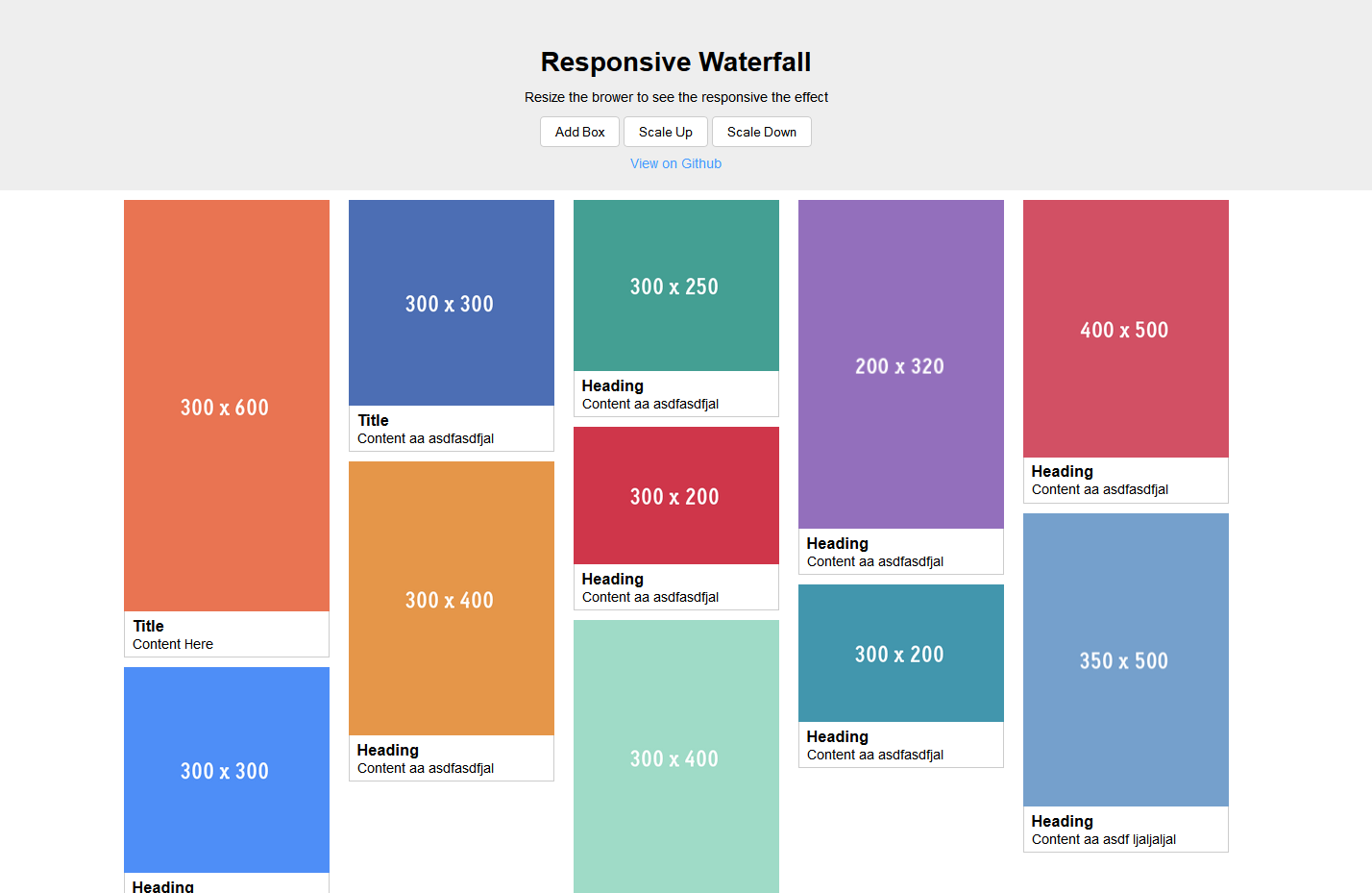Maison >interface Web >js tutoriel >Native JS implémente des compétences de layout_javascript de flux de cascade réactif
Native JS implémente des compétences de layout_javascript de flux de cascade réactif
- WBOYWBOYWBOYWBOYWBOYWBOYWBOYWBOYWBOYWBOYWBOYWBOYWBoriginal
- 2016-05-16 16:06:131347parcourir
Disposition du flux en cascade implémentée par JS natif, code et adresse du code de démonstration : https://github.com/leozdgao/responsive_waterfall
Démo :http://leozdgao.github.io/demo/responsive_waterfall/
Photo de démonstration :

Code de base :
responsive_waterfall.js
(function() {
var Waterfall = function(opts) {
var minBoxWidth;
Object.defineProperty(this, 'minBoxWidth', {
get: function() { return minBoxWidth; },
set: function(value) {
if(value < 100) value = 100;
if(value > 1000) value = 1000;
minBoxWidth = value;
}
});
opts = opts || {};
var containerSelector = opts.containerSelector || '.wf-container';
var boxSelector = opts.boxSelector || '.wf-box';
// init properties
this.minBoxWidth = opts.minBoxWidth || 250;
this.columns = [];
this.container = document.querySelector(containerSelector);
this.boxes = this.container ?
Array.prototype.slice.call(this.container.querySelectorAll(boxSelector)) : [];
// compose once in constructor
this.compose();
// handle the image or something which might change size after loaded
var images = this.container.querySelectorAll('img'), that = this;
var clr;
for (var i = 0; i < images.length; i++) {
var img = images[i];
img.onload = function() {
if(clr) clearTimeout(clr);
clr = setTimeout(function() {
that.compose(true);
}, 500);
}
}
window.addEventListener('resize', function() {
that.compose();
});
}
// compute the number of columns under current setting
Waterfall.prototype.computeNumberOfColumns = function() {
var num = Math.floor(this.container.clientWidth / this.minBoxWidth);
num = num || 1; // at least one column
return num;
}
// init enough columns and set the width
Waterfall.prototype.initColumns = function(num) {
if(num > 0) {
// create column div
this.columns = [];
var width = (100 / num) + '%';
while(num--) {
var column = document.createElement('div');
column.className = 'wf-column';
column.style.width = width;
this.columns.push(column);
this.container.appendChild(column);
}
}
}
// get the index of shortest column
Waterfall.prototype.getMinHeightIndex = function() {
if(this.columns && this.columns.length > 0) {
var min = this.columns[0].clientHeight, index = 0;
for (var i = 1; i < this.columns.length; i++) {
var columnElem = this.columns[i];
if(columnElem.clientHeight < min) {
min = columnElem.clientHeight;
index = i;
}
}
return index;
}
else return -1;
}
// compose core
Waterfall.prototype.compose = function(force) {
var num = this.computeNumberOfColumns();
var cols = this.columns.length;
if(force || num != cols) {
// remove old column
for (var i = 0; i < this.columns.length; i++) {
var columnElem = this.columns[i];
columnElem.remove();
}
// init new column
this.initColumns(num);
// compose
for (var i = 0, l = this.boxes.length; i < l; i++) {
var box = this.boxes[i];
this.addBox(box);
}
}
}
// add a new box to grid
Waterfall.prototype.addBox = function(elem) {
// push if new box
if(this.boxes.indexOf(elem) < 0) this.boxes.push(elem);
var columnIndex = this.getMinHeightIndex();
if(columnIndex > -1) {
var column = this.columns[columnIndex];
column.appendChild(elem);
}
}
window.Waterfall = Waterfall;
})()
Ce qui précède représente tout le contenu partagé avec vous dans cet article. J'espère qu'il sera utile à tout le monde pour utiliser efficacement Javascript.
Déclaration:
Le contenu de cet article est volontairement contribué par les internautes et les droits d'auteur appartiennent à l'auteur original. Ce site n'assume aucune responsabilité légale correspondante. Si vous trouvez un contenu suspecté de plagiat ou de contrefaçon, veuillez contacter admin@php.cn
Article précédent:Méthode JavaScript pour obtenir des compétences de soumission de formulaire Web method_javascriptArticle suivant:Méthode JavaScript pour obtenir des compétences de soumission de formulaire Web method_javascript
Articles Liés
Voir plus- Une analyse approfondie du composant de groupe de liste Bootstrap
- Explication détaillée du currying de la fonction JavaScript
- Exemple complet de génération de mot de passe JS et de détection de force (avec téléchargement du code source de démonstration)
- Angularjs intègre l'interface utilisateur WeChat (weui)
- Comment basculer rapidement entre le chinois traditionnel et le chinois simplifié avec JavaScript et l'astuce permettant aux sites Web de prendre en charge le basculement entre les compétences en chinois simplifié et traditionnel_javascript

